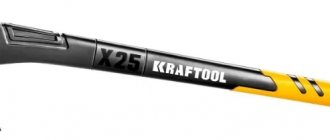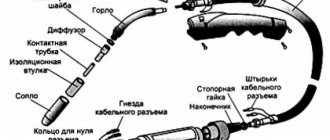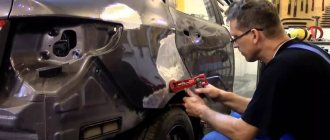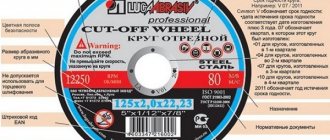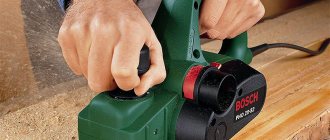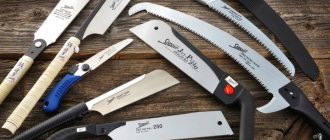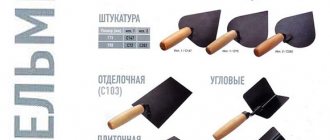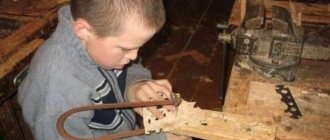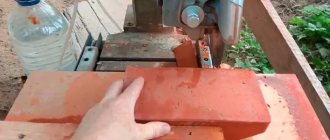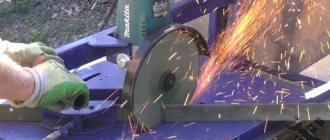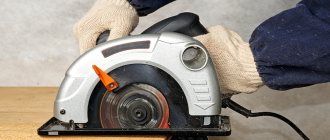Semi-automatic welding is an integral part of metal processing. Various metal structures are connected with its help in different industrial areas.
Semi-automatic welding is universal and can cope with metal of different thicknesses. It is possible to process non-ferrous and ferrous metals using this type of welding.
The method of connecting a metal structure using welding was developed in 1881 by N. G. Slavyanov and N. N. Benardos.
Description and principle of operation of semi-automatic welding
Semi-automatic welding is a welding process during which electrode wire is fed into the welding zone at a variable or constant speed with the simultaneous flow of active gas, inert gas or a gas mixture into the same zone, providing protection from the harmful effects of air on the heated or molten base and electrode metal.
Shielding gas is supplied through a gas reducer from a cylinder. In addition, semi-automatic welding provides a high-quality seam, making it easier to ignite the arc.
Due to the fact that the welder does not have to change electrodes and clean the seams from slag, the speed increases and the quality of the work done improves.
The working unit consists of:
- The main block, which in turn consists of a transformer that supplies power and a mechanism that supplies the electrode.
- Hose or welding sleeve for a semi-automatic machine.
- A burner that is equipped with an electrode inside.
- A conductive tip called a nozzle.
- Systems that supply inert gas.
For high-quality work, before starting wire welding, it is necessary to select the desired polarity of the current for welding. If the work is carried out using a flux electrode, then it is necessary to set the direct polarity, and if a gas environment is used, then the polarity must be reversed.
Welding technique
Before starting welding semi-automatic workpieces without gas (without carbon dioxide, in particular), you should always remember that when fusing vertical seams, vapors of combustible flux rise to the top.
In this case, it is most convenient to start the seam from the top of the workpiece, which is especially important when working with thin metal sheets.
When working with a semi-automatic machine, the torch handle must be held at a slight upward angle, since in this position it will be more convenient to hold the weld pool at the site of its formation.
The burner must move quickly enough along the joint being formed to prevent the formation of drops of molten metal. In this case, the wire itself is always fed to the front edge of the weld pool.
The type of semi-automatic welding under consideration without gas is somewhat reminiscent of working with a conventional electrode, during which slag sometimes flows into the molten pool.
By analogy, in this case, welders often have to make another one on top of the resulting seam, but only after the previous one has been cleared of slag.
The flux-cored wire used for welding without gas is soft enough, so that sharp bends in the hose are not allowed when handling and working with it.
When welding semi-automatically without gas, it is strictly prohibited to use ordinary wire, as this can lead to the formation of a poor-quality seam (with irregularities and voids). In addition, there will be an overexpenditure associated with the useless evaporation of the protective coating.
How to choose wire for a semi-automatic machine
It is necessary to select this device for welding using a semi-automatic machine based on what materials will be welded together.
For non-ferrous and refractory metals, welding wire is used, which has a wide variety of types, which are selected specifically for each case.
The main selection criterion is the chemical composition.
The designation uses numbers and letters that can be easily deciphered if you know what they mean.
For example, SV-08G2S stands for welded wire, which has a mass fraction of alloyed elements - 0.8% carbon; G means that the composition contains 2% manganese; C means that the composition contains no more than 1% silicon.
Best Activated Welding Wire
Activated wire is most often used for welding in an environment with carbon dioxide, as well as its mixtures and in a gas environment.
It consists of a powder that fills the electrode with only 7% of the total weight of the shell. Activation of the SV-08G2S , which is the base, occurs with the help of alkaline earth and alkali metal salts, which can easily be ionized.
SV-08G2S-O
- Available in the form of skeins, plastic or frame cassettes up to 18 kg;
- chemical composition: Mn - from 1.81% to 2.10%; C - from 0.051% to 0.12%; Si - from 0.71% to 0.95%; P - up to 0.031%; S - up to 0.026%;
- packaging - sold in waterproof two-layer paper, container fabric, wooden containers;
- diameter - from 0.8 mm to 4.0 mm;
- application - processing of low-carbon and carbon steel structures in protective gases.
ER 5356
- Available in the form of plastic cassettes of 1, 5, 7 kg, plastic tubes of 5 kg;
- chemical composition: Mn - up to 0.151%; Si - up to 0.26%; Cr - up to 0.12%; Fe - up to 0.41%; Mg - up to 5.1%;
- packaging - sold in two-layer waterproof paper, container fabric;
- diameter - from 0.8 mm to 5.0 mm;
- application - processing of aluminum-magnesium metal structures with protective gas.
Pros: The advantages of welding using an activated view are:
- increasing the stability of the arc, which significantly improves the seam and its formation quality;
- this type can be subjected to repeated bending without being flattened or wrinkled in the feed roller;
- Due to the low thermal conductivity of the alkali metal, which is included in the composition, the welding zone is protected from heat loss.
Aluminum wire for semi-automatic machine
Semi-automatic aluminum welding wire is used in cases where it is necessary to connect surfaces made of aluminum and its alloys in a shielding gas environment. In addition to aluminum itself, the consumable material contains iron, silicon, manganese and magnesium. The welding process is quite complicated, since aluminum has a lower melting point than the oxide film formed on its surface. It is extremely important to select a higher welding current; current collecting tips must have a larger hole diameter.
Wire for semi-automatic welding of aluminum is widely used in industry (especially food industry), shipbuilding and aircraft construction. You can make T-joints, butt seams, and also overlap metal sheets. High-quality aluminum wire for a semi-automatic machine, in addition to fusibility, must have the following characteristics:
- Excellent electrical and thermal conductivity.
- A small mass.
- Low biological activity.
- Resistant to moisture and aggressive environments.
- Strength.
- Flexibility.
- Long shelf life.
The interstate standard assumes that aluminum welding wire for semi-automatic machines is manufactured with increased strength (ATp), hard (AT), semi-hard (ATP) and soft (AM). When welding with aluminum wire for a semi-automatic machine, you should ensure that the arc length does not exceed 12-15 mm. Otherwise, it is likely that the metal will be burned through.
For welding aluminum semi-automatically without gas, flux-cored filler wire is suitable. However, keep in mind: it imparts some porosity to the weld, so it is better for welding products that are not subject to intense load.
Best Flux Cored Welding Wire
Flux-cored welding wire is characterized by the continuity of the electrode, consisting of a charge (powder core) and a metal sheath.
The continuous melting process is possible thanks to the metal shell, which holds the core and along the surface of which the welding current passes.
High-performance melting, which is characteristic of flux-cored wire, is carried out by high-density welding current.
PL-AN101
- Available in the form of skeins of 75-175 kg;
- chemical composition: C - up to 2.71%; Mn - up to 1.31%; Si – up to 3.3%; S - up to 0.071%; P - up to 0.081%; Cr - up to 25%; Ni - up to 4.01%;
- packaging - in waterproof or bitumen paper, plastic film;
- diameter - 16.5 mm * 3.8 mm;
- Application: welding of high-strength structures.
SV-07Х25Н13
- Available in the form of coils of 1-15 kg;
- chemical composition: C - up to 0.09%; Mn - from 1.1% to 2.01%; Si - from 0.5% to 1.01%; S - up to 0.018%; P - up to 0.026%; Cr - from 23% to 26%; Ni - from 12% to 14%;
- packaging - in waterproof or bitumen paper, plastic film;
- diameter - from 0.8 mm to 1.6 mm;
- Application: welding of stainless steel structures.
Pros: The advantages of the powder form are:
- due to the fact that welding occurs with a high-density current, the metal shell is provided with additional heating, which increases the volume of the surface that is processed;
- this type melts with high productivity up to 11 kg/h;
- the charge can consist of various powdered materials, making it possible to create mixtures that cannot be obtained in any other way.
Cons: The disadvantages of this type are:
- has satisfactory impact resistance;
- the tubular design of the electrode has low rigidity, which leads to the need to use a mechanism with limited compression forces in the feed rollers;
- work requires increased welding currents, which makes it difficult to work in a vertical position.
